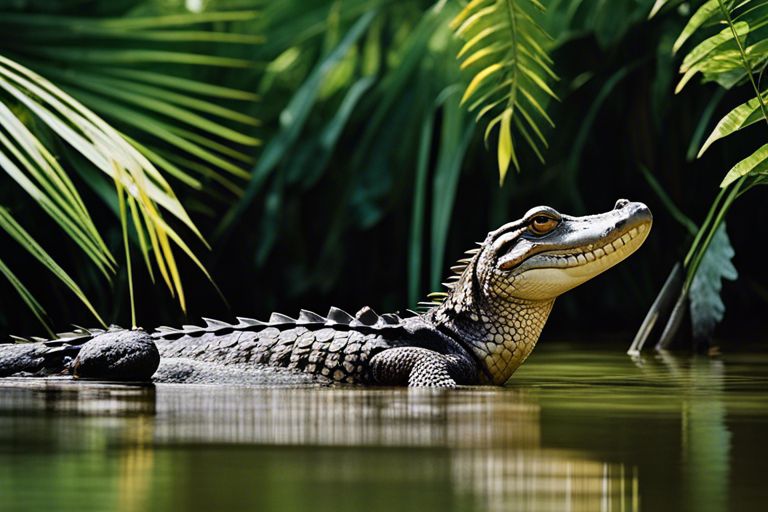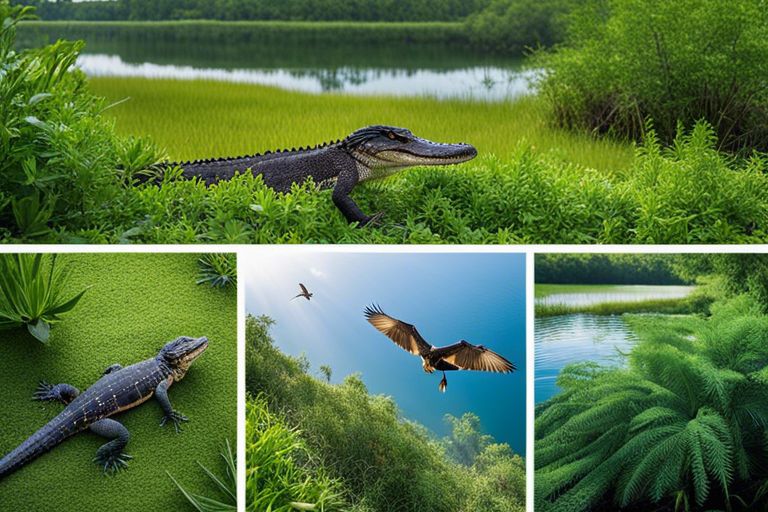Your cart is currently empty!

Why Is The Everglades Home To Some Of The Rarest Reptiles?
Reptiles inhabiting the Everglades are a diverse and unique group, making this ecosystem a hotspot for some of the rarest reptile species on the planet. Due to its vast expanse of subtropical wetlands, the Everglades provides a perfect habitat for a wide variety of reptiles to flourish. This blog post will investigate into the specific reasons why the Everglades has become a sanctuary for these elusive and fascinating creatures, shedding light on the importance of this ecosystem for reptile conservation.
Unique Ecosystem of the Everglades
For centuries, the Everglades has been renowned for its unique and diverse ecosystem that is home to some of the rarest reptiles in the world. This vast subtropical wilderness in Florida is a mosaic of different habitats that together form a complex and fragile environment unlike any other.
Geographical Characteristics
To understand the unparalleled biodiversity of the Everglades, one must first look at its geographical characteristics. The Everglades is a shallow, slow-moving river that is over 60 miles wide with a unique mosaic of habitats that include sawgrass marshes, cypress swamps, pinelands, and mangrove forests. This diverse landscape provides a variety of niches for reptiles to thrive and adapt to different environments.
With its slow-moving waters and low-lying topography, the Everglades is prone to seasonal flooding and drought cycles that shape the ecosystem and create unique habitats for reptiles. The interconnected waterways and wetlands allow for movement and migration of reptiles, contributing to the biodiversity of the region.
Climatic Influences
On top of its geographical features, the climate of the Everglades plays a crucial role in supporting its rare reptile species. The region experiences a subtropical climate characterized by high humidity, warm temperatures, and a distinct wet and dry season. These climatic influences create a dynamic environment that reptiles have evolved to thrive in.
Any slight change in the climate patterns of the Everglades can have a significant impact on its reptile populations. Even minor shifts in temperature or rainfall can alter the availability of food sources, breeding habitats, and nesting sites for these rare reptiles, making them vulnerable to environmental changes.
Rarest Reptiles in the Everglades
Even though the Everglades is known for its diverse wildlife, it is also home to some of the rarest reptiles in the world. These reptiles have adapted to the unique ecosystem of the Everglades, making it their exclusive habitat.
Endemic Species
One of the reasons why the Everglades is a hotspot for rare reptiles is because of its endemic species. Endemic species are those that are unique to a specific geographic location and cannot be found anywhere else in the world. In the Everglades, endemic reptiles like the Everglades rat snake and the Key ring-necked snake are only found within the boundaries of the national park.
These endemic species have evolved over time to thrive in the Everglades’ particular environment, making them incredibly rare and valuable in terms of biodiversity. Conserving these endemic reptiles is crucial in preserving the delicate balance of the Everglades ecosystem.
Threatened Reptiles
The Everglades is also home to a number of threatened reptiles, adding to the rarity of the reptile population in the region. Threatened reptiles like the American crocodile and the Eastern indigo snake face various challenges due to habitat loss, pollution, and climate change.
The decline in population of these threatened reptiles is a concerning issue that conservationists and researchers are working to address. Efforts to protect and restore their habitats are crucial in ensuring the survival of these unique and precious species in the Everglades.
Plus, the presence of these rare and threatened reptiles in the Everglades underscores the importance of preserving this unique ecosystem for future generations to enjoy and appreciate. By understanding the significance of these reptiles and their role in the Everglades, we can take steps towards promoting conservation efforts and ensuring the survival of these remarkable creatures.
Conservation Efforts
Habitat Preservation
To ensure the survival of rare reptiles in the Everglades, habitat preservation is paramount. The unique flora and fauna of this ecosystem rely on the delicate balance of wetlands, marshes, and tree islands. Efforts are being made to protect these habitats from encroaching urban development, agricultural expansion, and pollution. By designating certain areas as protected reserves and enforcing strict conservation policies, we aim to safeguard the homes of these rare reptiles.
Scientists and conservationists are actively involved in restoring damaged habitats within the Everglades. By reintroducing native plant species, controlling invasive species, and promoting natural water flow patterns, we can recreate an environment where rare reptiles can thrive. Through public education and community engagement, we can raise awareness about the importance of preserving these habitats for future generations.
Species Recovery Programs
On top of habitat preservation, species recovery programs play a vital role in restoring populations of rare reptiles in the Everglades. These programs involve monitoring vulnerable species, conducting research on their behaviors and habitats, and implementing breeding initiatives to increase their numbers. By closely monitoring the populations of rare reptiles, we can identify threats and take necessary actions to protect them from extinction.
Species recovery programs often collaborate with local wildlife agencies, non-profit organizations, and research institutions to pool resources and expertise. By working together, these groups can maximize their impact and implement more effective conservation strategies. These programs also play a crucial role in advocating for policy changes and funding support to ensure the long-term success of conservation efforts in the Everglades.

Challenges and Threats
Human Impact
Impact of human activities on the Everglades poses a significant threat to the rare reptiles that call this unique ecosystem home. Urban development, agricultural expansion, and pollution have all taken their toll on the delicate balance of this natural habitat. Clearing of land for construction and farming disrupts the natural vegetation that provides shelter and food for reptiles, leading to habitat loss and fragmentation.
Additionally, pollution from run-off containing harmful chemicals and pesticides contaminates the water sources in the Everglades, affecting not only the reptiles but the entire ecosystem. These pollutants can bioaccumulate in the food chain, posing a long-term risk to the reptiles at the top of the food web.
Climate Change
To understand the impact of climate change on the rare reptiles of the Everglades, it is crucial to recognize the role of temperature in determining the survival and behavior of these species. Rising temperatures and changes in precipitation patterns have the potential to alter the distribution of reptiles, disrupt breeding cycles, and shift ecosystem dynamics. These changes can lead to mismatches in timing with key resources such as food availability and suitable nesting sites.
Climate change poses a complex and interconnected challenge to the conservation of rare reptiles in the Everglades. As temperatures continue to rise and extreme weather events become more frequent, it is imperative to implement adaptive management strategies that take into account the changing conditions of this fragile ecosystem.
Climate change is a critical factor that requires urgent attention in the conservation efforts for the rare reptiles of the Everglades. By understanding the specific vulnerabilities of these species to climate change, researchers and conservationists can develop targeted interventions to mitigate the adverse effects and ensure the long-term survival of these unique reptiles.
Summing up
Drawing together the factors of unique habitat, climate, and biodiversity, it becomes clear why the Everglades is home to some of the rarest reptiles. The combination of wetlands, swamps, and diverse ecosystems provides a perfect environment for these species to thrive. With such a delicate balance and specialized adaptations, these reptiles have carved out a niche in this unique corner of the world, making the Everglades a critical hub for reptile conservation efforts.
FAQ
Q: Why is the Everglades home to some of the rarest reptiles?
A: The Everglades provide a unique and diverse habitat for reptiles due to its varied ecosystems, such as marshes, swamps, and wetlands. This rich environment supports a wide range of prey species, making it an ideal hunting ground for rare reptiles.
Q: What are some of the rare reptiles found in the Everglades?
A: The Everglades is home to several rare reptiles, including the American crocodile, eastern indigo snake, and the Everglades snail kite. These species have specific habitat requirements that are met within the Everglades ecosystem.
Q: How does the Everglades ecosystem support the conservation of rare reptiles?
A: The Everglades National Park plays a crucial role in the conservation of rare reptiles by protecting their habitats and implementing conservation programs. Through efforts to restore and maintain the natural balance of the ecosystem, the Everglades contribute to the survival of these vulnerable species.
Leave a Reply